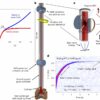Pushing for a higher speed isn’t just for athletes. Researchers, too, can achieve such feats with their discoveries. This is the case for Jinyang Liang, Professor at the Institut national de la recherche scientifique (INRS), and his team, whose research results have recently been published in Nature Communications.
The group based at INRS’s Énergie Matériaux Télécommunications Research Centre has developed a new ultrafast camera system that can capture up to 156.3 trillion frames per second with astonishing precision. For the first time, 2D optical imaging of ultrafast demagnetization in a single shot is possible.
This new device called SCARF (for swept-coded aperture real-time femtophotography) can capture transient absorption in a semiconductor and ultrafast demagnetization of a metal alloy. This new method will help push forward the frontiers of knowledge in a wide range of fields, including modern physics, biology, chemistry, materials science, and engineering.
Improving on past advances
Professor Liang is known around the world as a pioneer of ultrafast imaging. In 2018, he served as the principal developer of a major breakthrough in the field, which laid the groundwork for the development of SCARF.
Until now, ultrafast camera systems have mainly used an approach involving sequentially capturing frames one by one. They would acquire data through brief, repeated measurements, then put everything together to create a movie that reconstructed the observed movement.
“However, this approach can only be applied to inert samples or to phenomena that happen the exact same way each time. Fragile samples, not to mention non-repeatable phenomena or phenomena with ultrafast speeds, cannot be observed with this method.”
“For example, phenomena such as femtosecond laser ablation, shock-wave interaction with living cells, and optical chaos cannot be studied this way,” explains Liang.
The first tool developed by Professor Liang helped fill this gap. The T-CUP (Trillion-frame-per-second compressed ultrafast photography) system was based on passive femtosecond imaging capable of acquiring ten trillion (1013) frames per second. This was a major first step towards ultrafast, single-shot real-time imaging.
Yet challenges still remained.
“Many systems based on compressed ultrafast photography have to cope with degraded data quality and have to trade the sequence depth of the field of view. These limitations are attributable to the operating principle, which requires simultaneously shearing the scene and the coded aperture,” Liang continues.
SCARF overcomes these challenges. Its imaging modality enables ultrafast sweeping of a static coded aperture while not shearing the ultrafast phenomenon. This provides full-sequence encoding rates of up to 156.3 THz to individual pixels on a camera with a charge-coupled device (CCD). These results can be obtained in a single shot at tunable frame rates and spatial scales in both reflection and transmission modes.
A range of applications
SCARF makes it possible to observe unique phenomena that are ultrafast, non-repeatable, or difficult to reproduce, such as shock wave mechanics in living cells or matter. These advances could potentially be used to develop better pharmaceutics and medical treatments.
What’s more, SCARF promises very appealing economic spinoffs. Two companies, Axis Photonique and Few-Cycle, are already working with Professor Liang’s team to produce a marketable version of their patent-pending discovery. This represents a great opportunity for Quebec to strengthen its already enviable position as a leader in photonics.
The work was carried out in the Advanced Laser Light Source (ALLS) Laboratory in collaboration with Professor François Légaré, Director of the Énergie Matériaux Télécommunications Research Centre, and international colleagues Michel Hehn, Stéphane Mangin and Grégory Malinowski of the Institut Jean Lamour at the Université de Lorraine (France) and Zhengyan Li of Huazhong University of Science and Technology (China).
More information:
Jingdan Liu et al, Swept coded aperture real-time femtophotography, Nature Communications (2024). DOI: 10.1038/s41467-024-45820-z
Citation:
Pushing back the limits of optical imaging by processing trillions of frames per second (2024, March 25)



